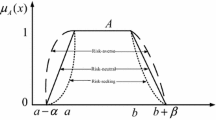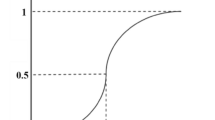Abstract
In this paper, we discuss a multi-period portfolio selection with discounted transaction costs in a fuzzy uncertain investment environment, which has not been given much attention before. We assume that an investor’s motivation is to find the portfolio with maximizing terminal wealth and the cumulative skewness on portfolios, and minimizing the cumulative risk on portfolios. We consider the major criteria including wealth, risk, skewness, transaction costs, proportion entropy, transaction lots, the maximum holding number of assets in the portfolio and budge constraint. We propose a possbilistic mean-semivariance-skewness model with discounted transaction costs for multi-period fuzzy portfolio selection. To solve the multi-objective portfolio selection model, we first introduce a weighted max–min fuzzy goal programming approach to take investor’s different investment preferences into account and transform it into a single-objective programming problem and then design a dynamic differential evolution algorithm for solution. Finally, we provide an empirical study with the sample data from Chinese stock market to analyze the application of the model and the performance of the solution algorithm.


Similar content being viewed by others
References
Abiyev RH, Menekay M (2007) Fuzzy portfolio selection using genetic algorithm. Soft Comput 11(12):1157–1163
Ali MM, Törn A (2004) Population set-based global optimization algorithms: some modifications and numerical studies. Comput Oper Res 31(10):1703–1725
Asafuddoula M, Ray T, Sarker R (2014) An adaptive hybrid differential evolution algorithm for single objective optimization. Appl Math Comput 231:601–618
Brest J, Greiner S, Boskovic B, Mernik M, Zumer V (2006) Self-adapting control parameters in differential evolution: a comparative study on numerical benchmark problems. IEEE Trans Evol Comput 10(6):646–657
Brieca W, Kerstens K (2009) Multi-horizon Markowitz portfolio performance appraisals: a general approach. Omega 37(1):50–62
Carlsson C, Fullér R (2001) On possibilistic mean value and variance of fuzzy numbers. Fuzzy Set Syst 122(2):315–326
Carlsson C, Fullér R, Majlender P (2002) A possibilistic approach to selecting portfolios with highest utility score. Fuzzy Set Syst 131(1):13–21
Chang TJ, Meade N, Beasley JE, Sharaiha YM (2000) Heuristics for cardinality constrained portfolio optimisation. Comput Oper Res 27(13):1271–1302
Chen W (2015) Artificial bee colony algorithm for constrained possibilistic portfolio optimization problem. Phys A 429:125–139
Chunhachinda P, Dandapani K, Hamid S, Prakash AJ (1997) Portfolio selection and skewness: evidence from international stock markets. J Bank Finance 21(2):143–167
Delgado M, Vila MA, Woxman W (1998) On a canonical representation of fuzzy numbers. Fuzzy Set Syst 93(1):125–135
Fang SC, Rajasekera JR, Tsao HSJ (1997) Entropy optimization and mathematical programming. Kluwer Academic Publisheres, Dordrecht
Gupta P, Mittal G, Mehlawat MK (2013) Expected value multiobjective portfolio rebalancing model with fuzzy parameters. Insur Math Econ 52(2):190–203
Ghazinoory S, Zadeh AE, Kheirkhah AS (2010) Application of fuzzy calculations for improving portfolio matrices. Inf Sci 180(9):1582–1590
Hakansson NH (1971) Multi-period mean-variance analysis: toward a general theory of portfolio choice. J Finance 26(4):857–884
Huang X (2011) Minimax mean-variance models for fuzzy portfolio selection. Soft Comput 15(2):251–260
Kamin JH (1975) Optimal portfolio revision with a proportional transaction cost. Manag Sci 21(11):1263–1271
Kapur JN (1990) Maximum entropy models in science and engineering. Wiley, New Delhi
Konno H, Yamamoto R (2005) Global optimization versus integer programming in portfolio optimization under nonconvex transaction costs. J Glob Optim 32(2):207–219
Li D, Ng WL (2000) Optimal dynamic portfolio selection: multiperiod mean-variance formulation. Math Finance 10(3):387–406
Li J, Xu JP (2013) Multi-objective portfolio selection model with fuzzy random returns and a compromise approach-based genetic algorithm. Inf Sci 220:507–521
Li X, Qin Z, Kar S (2010) Mean-variance-skewness model for portfolio selection with fuzzy returns. Eur J Oper Res 202(1):239–247
Lin CC (2004) A weighted max-min model for fuzzy goal programming. Fuzzy Set Syst 142(3):407–420
Liu YJ, Zhang WG (2015) A multi-period fuzzy portfolio optimization model with minimum transaction lots. Eur J Oper Res 242(3):933–941
Liu YJ, Zhang WG, Xu WJ (2012) Fuzzy multi-period portfolio selection optimization models using multiple criteria. Automatica 48(12):3042–3053
Lobo MS, Fazel M, Boyd S (2007) Portfolio optimization with linear and fixed transaction costs. Ann Oper Res 152(1):341–365
Markowitz H (1952) Portfolio selection. J Finance 7(1):77–91
Markowitz HM (1959) Portfolio selection: efficient diversification of investments. Wiley, NewYork
Mashayekhi Z, Omrani H (2016) An integrated multi-objective Markowitz-DEA cross-efficiency model with fuzzy returns for portfolio selection problem. Appl Soft Comput 38:1–9
Mehlawat MK (2016) Credibilistic mean-entropy models for multi-period portfolio selection with multi-choice aspiration levels. Inf Sci 345:9–26
Meza J, Espitia H, Montenegro C, Crespo RG (2015) Statistical analysis of a multi-objective optimization algorithm based on a model of particles with vorticity behavior. Soft Comput. doi:10.1007/s00500-015-1972-2
Mezura-Montes E, Miranda-Varela ME, Gómez-Ramón RC (2010) Differential evolution in constrained numerical optimization: an empirical study. Inf Sci 180(22):4223–4262
Mohamed AW, Sabry HZ (2012) Constrained optimization based on modified differential evolution algorithm. Inf Sci 194:171–208
Patel NR, Subrahmany MG (1982) A simple algorithm for optimal portfolio selection with fixed transaction costs. Manage Sci 28(3):303–314
Price K, Storn R, Lampinen J (2005) Differential evolution: a practical approach to global optimization. Springer, Berlin
Rodriguez SG (2013) Application of multiobjective evolutionary techniques for robust portfolio optimization. Int J Interact Multi Artif Intell 2(2):63–64
Saborido R, Ruiz AB, Bermúdez JD, Vercher E, Luque M (2016) Evolutionary multi-objective optimization algorithms for fuzzy portfolio selection. Appl Soft Comput 39:48–63
Sadjadi SJ, Seyedhosseini SM, Hassanlou Kh (2011) Fuzzy multiperiod portfolio selection with different rates for borrowing and lending. Appl Soft Comput 11(4):3821–3826
Sheen JN (2005) Fuzzy financial profitability analyses of demand side management alternatives from participant perspective. Inf Sci 169(3/4):329–364
Storn R, Price K (1995) Differential evolution-a simple and efficient adaptive scheme for global optimization over continuous spaces. Technical report TR-95-012, International Computer Science Institute, Berkeley, CA
Yao H, Li Z, Li D (2016) Multi-period mean-variance portfolio selection with stochastic interest rate and uncontrollable liability. Eur J Oper Res 252(3):837–851
Yu L, Wang S, Lai KK (2008) Neural network-based mean-variance-skewness model for portfolio selection. Comput Oper Res 35(1):34–46
Yu JR, Lee WY (2011) Portfolio rebalancing model using multiple criteria. Eur J Oper Res 209(2):166–175
Zadeh LA (1965) Fuzzy sets. Inf Control 8(3):338–353
Zhang WG, Zhang XL, Xiao WL (2009) Portfolio selection under possibilistic mean-variance utility and a SMO algorithm. Eur J Oper Res 197(2):693–700
Zhang WG, Zhang XL, Xu WJ (2010) A risk tolerance model for portfolio adjusting problem with transaction costs based on possibilistic moments. Insur Math Econ 46(3):493–499
Zhang WG, Liu YJ, Xu WJ (2012) A possibilistic mean-semivariance-entropy model for multi-period portfolio selection with transaction costs. Eur J Oper Res 222(2):341–349
Zhang XL, Zhang WG, Xiao WL (2013) Multi-period portfolio optimization under possibility measures. Econ Model 35:401–408
Zhang WG, Liu YJ, Xu WJ (2014) A new fuzzy programming approach for multi-period portfolio optimization with return demand and risk control. Fuzzy Set Syst 246:107–126
Acknowledgments
This research was supported by the National Natural Science Foundation of China (No. 71501076), the Natural Science Foundation of Guangdong Province of China (No. 2014A030310454), Guangzhou Financial Services Innovation and RiskManagement Research Base, the Soft Science Key Project of Guangdong Province Technology Plan (No. 2014A070702004) and Youth project of the Ministry of the National Education Science Program (ELA140380).
Author information
Authors and Affiliations
Corresponding authors
Ethics declarations
Conflict of interest
The authors declare no conflict of interest.
Ethical approval
This article does not contain any studies with human participants or animals performed by any of the authors.
Additional information
Communicated by V. Loia.
Rights and permissions
About this article
Cite this article
Liu, YJ., Zhang, WG. & Zhao, XJ. Fuzzy multi-period portfolio selection model with discounted transaction costs. Soft Comput 22, 177–193 (2018). https://doi.org/10.1007/s00500-016-2325-5
Published:
Issue Date:
DOI: https://doi.org/10.1007/s00500-016-2325-5




